This week we were asked to observe
an adult and young child communicating with each other. I chose to observe in
one of the kindergarten classes in my school. While in the class, I had the opportunity to
observe one of the students with the personal assistant assigned to the child.
The child has frequent tantrums and requires additional adult support in her
classroom setting.
While in the classroom I noticed
that the child and her assistant were sitting at a table with the other
children. They were completing a Thanksgiving worksheet that the teacher had
given. What drew my attention to the pair was the conversation that took place
between the child and her assistance. The little girl did not want to complete
the assignment and even put her elbows on the table and refused to color her
paper. The assistant spoke to the child in a very calm voice and said, “If you
start the picture, I’ll help you finish it”. The child abruptly said no. The
assistance then said, “Here, you can see the green crayon, or the orange crayon”.
The children then took the green crayon and began to color. True to her word,
the assistant started to help the child with the coloring paper. Once the child
started the paper she then decided to use other colors. The assistant spoke to
her in a very soothing voice and praised her for following directions and told
her that her work looked nice. I think
the desired outcome was to have the child begin the assignment and the
assistant accomplished that by providing a calm voice in a situation that could
have escalated if she had yelled at the student.
While the child colored her paper
she started talking to her assistant about what she wanted to eat for lunch. The
child told the assistant that she was going to get chicken nuggets and began to
smile. The assistant engaged her by smiling and saying, “I know how much you
like them”. The child giggled and
continued to do her work. As the child kept working the assistant continued to
praise her and reminder her that she could earn a sticker and computer time
when she finished her work. The child started to smile and the assistant smiled
back at her. Before I left the room I
gave the assistant the thumbs up sign.
My Thoughts
I really liked the way the
assistant worked with the student she’s assigned to. The beginning of the year
was a big transition for this child because she was in our pre-kindergarten
program which is a half day program. She is now in an all day kindergarten
program. This is also her first year having an assistant so Ms. Cook has had to
establish a relationship with her. I just like the way Ms. Cook stayed calm
even when the child became upset. Children can often feed off of the emotions
of the adults. Her sense of calm caused the situation to deescalate. I thought
she was very respectful to the child throughout the interaction. She
acknowledged that the child was upset and even offered to help her with the
assignment. I think she also set expectations by offering the child a choice of
the crayons she was going to use to complete the assignment. By giving her a
choice, the child felt a sense of control. Ms. Cook was able to get the child
to finish her work without forcing her to do it. The interactions between the
child and the assistant were positive.
The interaction that I observed in
the kindergarten class is very similar to what I try to do in my own classroom.
It was clear to see there was respect for the child. In the course media this
week, Lisa Kolbeck spoke about the importance of showing children respect and listening
and providing them with assurance. Ms. Cook did a nice job of respecting and
listening to the child.
This assignment reminded me of a
course that was offered in my county. The course was called Hanen
Training - Encouraging Language Development in Early Childhood Setting. This course focused on watching how children
play and instead of doing the talking, the key was to first observe to see how
children learn. After talking to Ms. Cook, she said that she was encouraged by
another special educator to see how to manipulative her environment. Ms. Cook
shared that once she learned what the child liked and didn’t like, it helped
her with the interactions that she had with the child. She said she quickly learned
that yelling only made situation escalate with the child. I think this week I
learned the importance of sometimes watching how children interact within their
environment before interacting with them.
Reference
